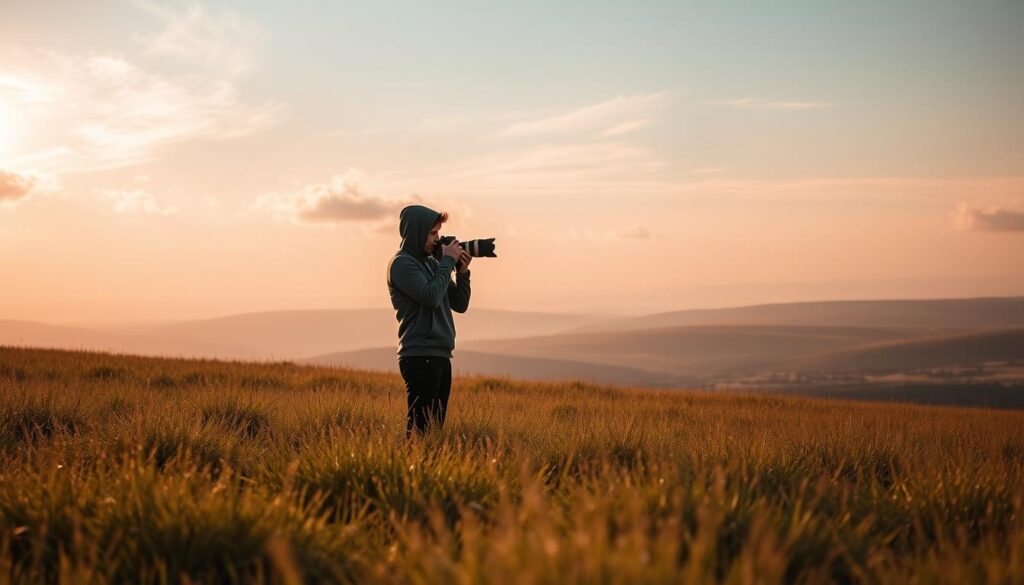Growing your creative venture online requires more than stunning visuals. Strategic adjustments to your digital presence can dramatically increase visibility and help potential clients find your work. This guide simplifies actionable steps to improve search rankings and drive meaningful traffic to your portfolio.
Whether you specialize in weddings, portraits, or commercial projects, a well-structured online platform acts as your 24/7 storefront. We’ll explore practical ways to optimize content, refine technical elements, and create seamless user experiences. These methods work together to make your site more attractive to search algorithms and human visitors alike.
You’ll learn how to highlight your unique style while meeting modern search standards. No jargon or complex theories – just clear, photographer-focused advice. Let’s turn your passion into discoverable art that connects with your ideal audience.
Key Takeaways
- Strategic website improvements can significantly increase client inquiries
- Balancing creative content with technical optimization drives better search rankings
- Clear site navigation helps visitors and search engines understand your services
- Regular content updates keep your portfolio fresh and relevant
- Mobile-friendly designs improve user experience and search performance
Introduction: Why SEO Matters for Photographers
Your visual artistry deserves an audience that can find you effortlessly. While social media platforms help showcase work, they don’t guarantee long-term visibility. Strategic optimization ensures your website appears when potential clients look for services you offer.
Building Blocks of Online Visibility
At its core, optimization involves aligning your content with what people type into search bars. For example, a wedding photographer might focus on phrases like “luxury Boston wedding photos” rather than generic terms. These specific phrases become the foundation for tailoring your page titles, descriptions, and blog posts.
| Focus Area | Foundation | Connection |
|---|---|---|
| Service Pages | Location-based keywords | Matches local client searches |
| Blog Content | Trending style keywords | Attracts niche audiences |
| Portfolio Tags | Equipment-specific terms | Appeals to detail-oriented clients |
From Clicks to Clients
When search engines properly index your pages, your work appears in relevant results more consistently. This process turns casual browsers into booked clients. A well-optimized site acts like a 24/7 referral engine, highlighting your specialty areas without extra advertising costs.
Simple changes—like using descriptive filenames for images or structuring URLs clearly—make your content easier to discover. Over time, these adjustments compound, helping you outrank competitors in local and niche markets.
Understanding SEO and Its Impact on Your Online Presence
Your online portfolio acts as a digital handshake between your work and potential clients. High-quality content plays a starring role here, serving as the bridge that connects your artistic vision with search engine algorithms. When your website offers original, well-structured information, it becomes easier for platforms like Google to recognize and recommend your services.

A well-organized site does double duty. It helps visitors navigate your photography portfolio effortlessly while signaling to search crawlers that your pages deserve attention. Think of your website’s structure as a gallery curator – it should highlight your best work and guide viewers toward taking action, like booking a session or exploring your services.
Every image you upload tells a story beyond its visual appeal. File names like “sunset-portrait-denver.jpg” and descriptive alt text help search engines understand your business focus. This clarity improves your chances of appearing in location-based searches, especially when paired with blog posts or service pages that address specific client needs.
Search engines index sites by scanning and categorizing content relevance. Fresh updates – like adding recent projects or refining page descriptions – keep your digital presence dynamic. Over time, this consistent effort builds authority, making your site a trusted resource for both algorithms and art-seeking audiences.
Mastering “seo for photographers” Strategy
Building a discoverable online portfolio starts with understanding what your ideal clients are searching for. Effective keyword research helps bridge the gap between your creative services and the phrases people use to find them. Let’s explore how to identify terms that match your specialty while staying authentic to your brand.
Identifying the Right Keywords
Begin by listing services you offer and locations you serve. A portrait specialist in Miami might target “outdoor family photos South Beach” instead of generic terms like “best photographer.” Tools like Google Keyword Planner reveal search volumes, while platforms like AnswerThePublic show real questions clients ask.
- Combine cities with photography styles: “Denver elopement packages”
- Include equipment references for technical clients: “medium format landscape photography”
- Analyze competitor sites for gaps in their keyword strategies
Integrating Keywords Naturally Across Your Site
Once you’ve chosen target phrases, weave them into your text without disrupting readability. Place primary keywords in headings, service descriptions, and blog introductions. For example:
“Our New York City architectural photography services capture iconic skyline details through unique angles and lighting techniques.”
Track performance monthly using free tools like Google Search Console. Notice which terms drive traffic, then refine your approach. Over time, this balance of strategic planning and organic content creation strengthens your visibility without sacrificing artistic integrity.
Optimizing Website Content for Better Rankings
Transform your online content into client magnets by blending creativity with search-friendly practices. High-quality text acts as a dual-purpose tool—it showcases your artistic voice while meeting technical requirements that boost visibility.

Content That Connects and Converts
Compelling titles serve as your first impression. Phrases like “5 Questions to Ask Before Booking a Portrait Session” grab attention in search results and social shares. These headlines work harder when paired with clear meta descriptions that preview your unique approach.
Regular blog updates keep your site fresh and relevant. Share behind-the-scenes stories or client spotlights to humanize your brand. Search algorithms favor websites that consistently add value, while visitors appreciate authentic insights into your creative process.
| Content Type | Focus Area | Impact |
|---|---|---|
| Blog Posts | Answer common client questions | Boosts ranking for niche topics |
| Service Pages | Highlight location specialties | Attracts local searches |
| Image Descriptions | Use style-specific keywords | Improves visual search results |
Balance artistic storytelling with strategic keyword placement. Instead of forcing terms, let them emerge naturally in project explanations or client testimonials. This approach maintains readability while signaling relevance to search crawlers.
Update existing pages quarterly. Refresh outdated pricing details or add new portfolio samples to maintain momentum. Consistent improvements help sustain traffic growth and client engagement over time.
Image Optimization Techniques for Photographers
Your photographs tell stories, but search engines need help understanding them. Optimizing visual content bridges this gap, making your work discoverable while maintaining its artistic impact. Let’s explore techniques that enhance visibility without compromising quality.
Smart File Naming and Descriptive Text
Replace generic filenames like “IMG_1234.jpg” with descriptive terms. For example, “chicago-skyline-wedding-photos.jpg” tells algorithms exactly what the image shows. This simple change helps your work appear in relevant searches.
Alt text acts as a caption for screen readers and search crawlers. Avoid stuffing keywords – instead, describe the scene naturally. Compare these examples:
- Weak: “Bride photo”
- Strong: “Outdoor summer wedding portrait with mountain backdrop in Colorado”
Compression tools like Shortpixel reduce file sizes while preserving detail. Faster-loading pages keep visitors engaged and improve search rankings. Aim for images under 500KB without noticeable quality loss.
Well-optimized visuals often appear in image search results, driving traffic to your portfolio. Pair compressed files with proper naming conventions to create a seamless experience. These adjustments work together to make your artistry both visible and impactful.
On-Page SEO Tactics for Photographers
Crafting compelling page elements helps potential clients discover your work. Clear titles and descriptions act as virtual signposts, guiding visitors through your web content while satisfying search algorithms.
Title Tags That Grab Attention
Think of title tags as your website’s business card in search results. Effective examples combine location, specialty, and value:
“Chicago Event Photography | Modern Corporate Headshots”
This format outperforms vague titles like “Portfolio Page 5.” Meta descriptions should preview page content in 1-2 concise sentences. Include action verbs and primary keywords naturally.
Content That Holds Interest
Every photo gallery and blog post should serve a clear purpose. Structure websites with intuitive menus and internal links to keep visitors exploring. Compare these approaches:
| Element | Weak Example | Strong Example |
|---|---|---|
| Service Page Title | “About Us” | “Fine Art Wedding Photography Services in Austin” |
| Blog Post Description | “Tips for better photos” | “5 Lighting Techniques for Dramatic Portrait Sessions” |
| Portfolio Section | “Recent Work” | “Commercial Architecture Photography Portfolio” |
Update posts quarterly with fresh examples and client stories. Remove outdated galleries to maintain relevance. This balance of strategic updates and quality focus keeps both visitors and algorithms engaged.
Technical SEO: Enhancing Website Performance
Your website’s technical backbone quietly shapes how easily clients find your work. Fast-loading pages and mobile-friendly designs create smooth experiences that keep visitors engaged. These behind-the-scenes improvements work alongside your stunning visuals to build trust with both audiences and search algorithms.

Speed matters more than ever. Compressing images without losing detail and choosing quality hosting can cut load times by half. For instance, a portfolio that once took 5 seconds to load might now appear instantly – a game-changer for impatient browsers.
Clean code acts as a roadmap for search crawlers. Eliminate broken links and streamline CSS files to help algorithms understand your content. Tools like Google PageSpeed Insights give actionable suggestions, such as removing unused plugins or enabling browser caching.
Sitemaps serve as a master index for your pages. Submitting them through Google Search Console ensures new work gets noticed quickly. Regular quality assurance checks catch issues like duplicate meta titles before they hurt rankings.
Technical upgrades create ripple effects. A responsive design isn’t just mobile-friendly – it’s the way visitors interact with your art on any device. Faster sites also rank higher, making these improvements a foundational way to boost visibility over time.
Building Quality Backlinks and Internal Links
Your website’s connections act like a trusted referral network. When other sites link to yours, search engines view your content as more authoritative. This credibility boost helps your pages climb in search results, putting your work in front of ideal clients.
Creating Meaningful Partnerships
Earn backlinks by collaborating with industry peers and local businesses. For example:
- Write guest posts for wedding blogs featuring your photography
- Partner with venues to showcase event photos on their sites
- Contribute expert tips to photography education platforms
These relationships create win-win scenarios. You gain exposure while partners receive fresh content. Focus on websites your clients frequent – their endorsements carry more weight in search engine algorithms.
| Backlink Source | Benefit | Example |
|---|---|---|
| Industry Blogs | Targets niche audiences | Featured in “Modern Wedding Trends” article |
| Local Directories | Boosts regional visibility | Listed in “Top Boston Portrait Artists” guide |
| Client Websites | Builds social proof | Featured in corporate event recaps |
Internal links guide visitors through your content naturally. Link blog posts about lighting techniques to relevant portfolio galleries. This keeps visitors engaged while helping search engines understand your site’s structure.
Social media plays a supporting role here. Share your latest collaborations across platforms to attract organic links. A styled shoot featured on Instagram might get picked up by multiple blogs, creating a ripple effect in search results.
Balance external endorsements with smart internal pathways. This dual approach satisfies both human visitors and algorithmic crawlers, making your site a hub of discoverable artistry.
Utilizing SEO Tools and Analytics
Your website’s performance becomes clearer when you track what’s working. Free tools like Google Search Console and Analytics turn guesswork into actionable insights. These platforms reveal how visitors interact with your content and where improvements can boost visibility.
Mastering Essential Platforms
Start by verifying your site in Google Search Console. This tool shows which pages search engines index and flags issues like broken links. Check the Coverage Report monthly to ensure your best work appears in search results.
Google Analytics digs deeper into visitor behavior. Track metrics like:
- Page views for portfolio galleries or service listings
- Bounce rates indicating content relevance
- Traffic sources showing where clients find you
Set up custom dashboards to monitor key performance indicators. Notice which blog posts drive the most inquiries or which portfolio pieces keep visitors engaged longest. Use these patterns to refine your engine optimization approach.
Regular data reviews help you adapt quickly. If a service page has high exit rates, test different calls-to-action or images. When certain keywords gain traction in google search results, create related content to capitalize on the trend.
Understanding how search engines work simplifies decision-making. Prioritize fixes that impact visibility most – like improving slow-loading pages or optimizing underperforming meta tags. Consistent tweaks based on reliable data keep your strategy aligned with real-world results.
Integrating Social Media and Digital Portfolios
Your digital portfolio and social media channels should work like a dynamic duo, amplifying each other’s strengths. Sharing recent projects on Instagram or Pinterest drives visitors directly to your website. These platforms act as discovery engines, introducing your work to new audiences while reinforcing your domain authority.
Consistent branding across platforms builds recognition. Use the same profile photo, bio links, and color schemes to create a cohesive identity. When followers click through to your site, they’ll immediately recognize your style – turning casual scrollers into potential clients.
| Platform | Strategy | Outcome |
|---|---|---|
| Share behind-the-scenes reels | Drives traffic to blog posts | |
| Create themed boards | Boosts image search visibility | |
| Publish client case studies | Attracts corporate partnerships |
Collaborate with local venues or influencers to earn quality backlinks. A wedding venue might feature your photos on their blog, linking back to your portfolio. These endorsements signal credibility to search algorithms and human audiences alike.
Storytelling ties everything together. Pair portfolio images with captions that explain your creative process:
“This sunset elopement shoot required hiking three miles with gear – but the golden-hour payoff was worth every step.”
Schedule weekly posts showcasing different services. Rotate between client testimonials, technical tips, and portfolio highlights. This variety keeps content fresh while encouraging shares – a win for engagement and visitors growth.
Practical Tips to Increase Your Search Engine Ranking
Your website’s navigation acts as a roadmap for both visitors and search crawlers. Thoughtful connections between pages improve user experience while signaling content relevance. These strategies help your work stand out in crowded digital spaces.
Strategic Pathways for Better Navigation
Internal links guide visitors to related content naturally. Instead of generic “click here” phrases, use descriptive anchor text:
- Weak: “See our gallery”
- Strong: “Explore our New York City architecture portfolio”
| Element | Common Mistake | Improved Approach |
|---|---|---|
| Image alt text | “Photo123.jpg” | “Bridal portrait at Golden Gate Park” |
| Page URLs | /services/page5 | /san-diego-wedding-photography |
| Meta descriptions | “Learn more here” | “Discover modern maternity photography sessions in Dallas” |
Consistent url structures make sites easier to crawl. Match page titles to web addresses – if a service page is called “Urban Fashion Shoots,” its url should reflect that exact phrase.
Page descriptions serve dual purposes. They preview content for search engines while enticing human readers. Keep them under 160 characters and include primary keywords organically.
Small changes create big impacts over time. A blog post about lighting techniques could link to your portrait portfolio using specific alt text like “studio lighting setup for dramatic headshots.” These connections help search engines understand relationships between your content areas.
Conclusion
Elevating your online presence requires blending artistry with smart digital strategies. By focusing on targeted keywords, optimized visuals, and technical refinements, you create pathways for clients to discover your unique style.
A balanced approach delivers lasting results. Combine detailed service pages with mobile-friendly designs. Pair fresh blog content with strategic backlinks. These elements work together to boost visibility across search platforms.
Use free tools like Google Search Console to track progress. The insights gained from these guides help refine your approach over time. Small changes – updating image tags or improving site speed – often yield noticeable improvements.
Begin implementing these strategies today. Choose one area to enhance this week, whether rewriting page titles or compressing portfolio files. Consistent effort builds momentum, turning your website into a powerful client-attraction tool.
Stay curious as algorithms evolve. Bookmark trusted guides for updates, and revisit your strategy quarterly. Your creative work deserves an audience that finds it effortlessly – now you have the tools to make that happen.
